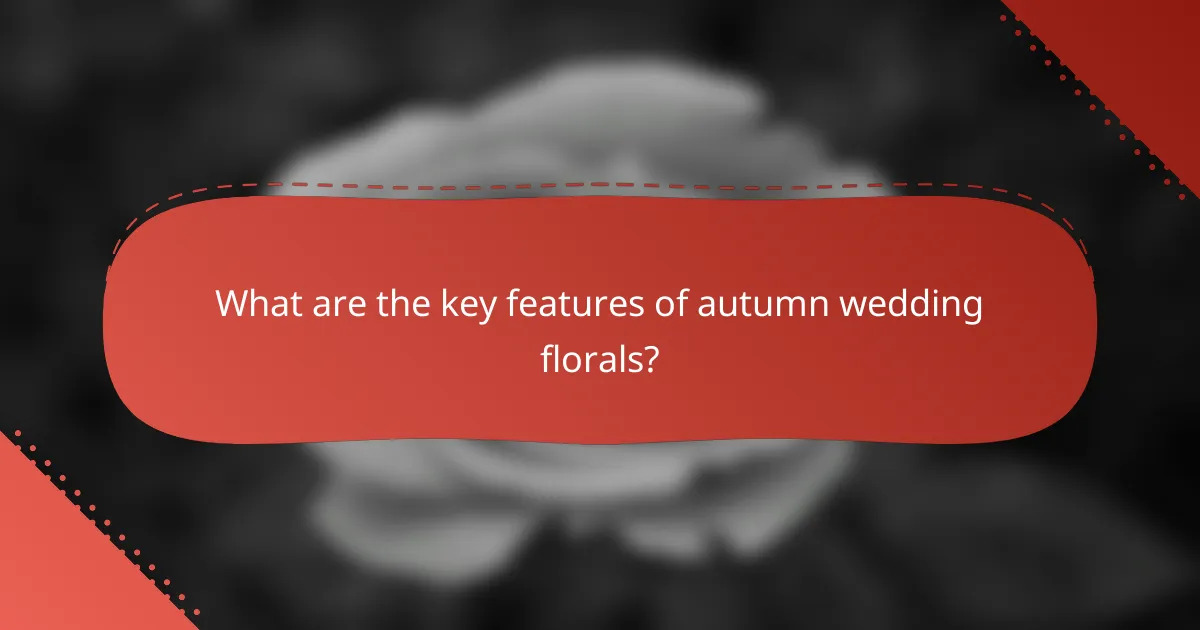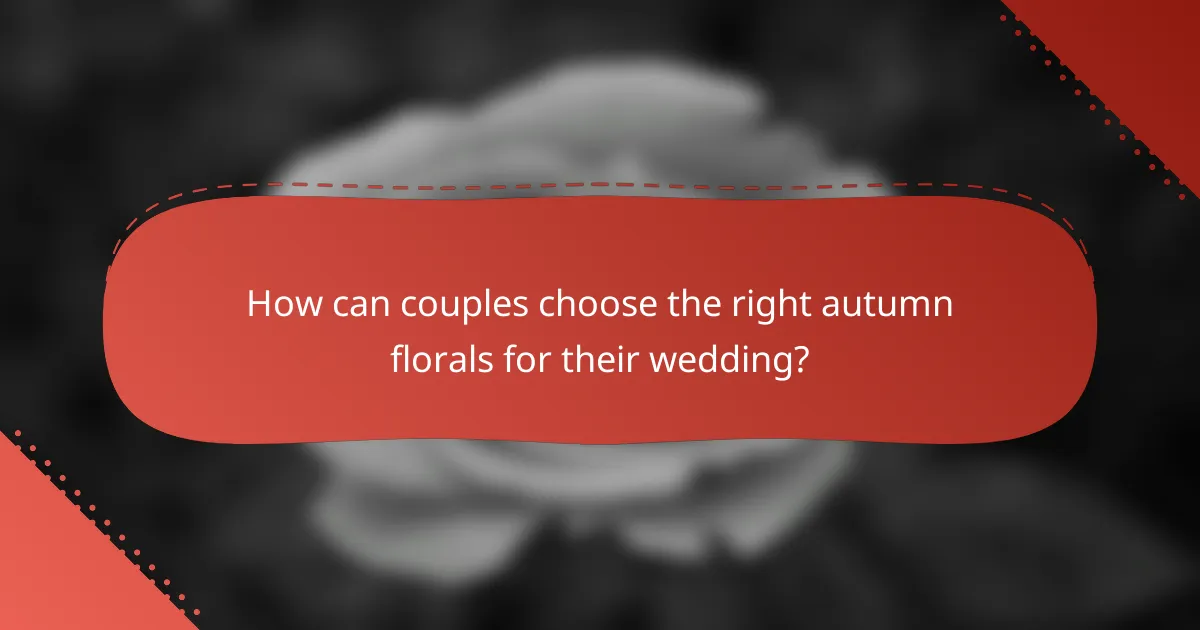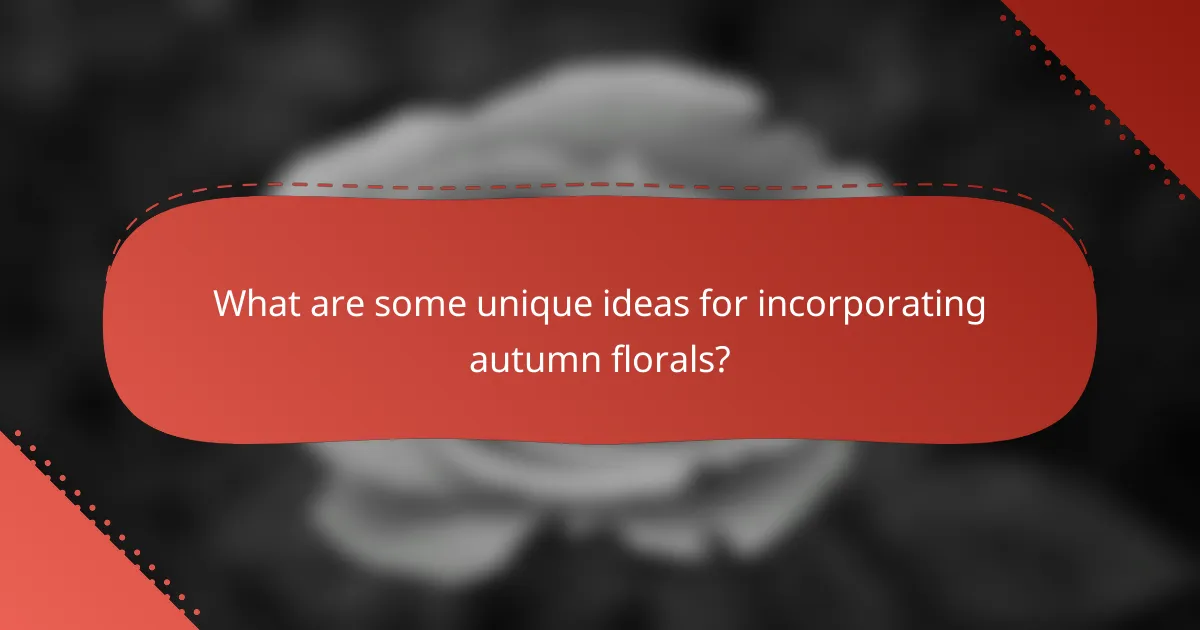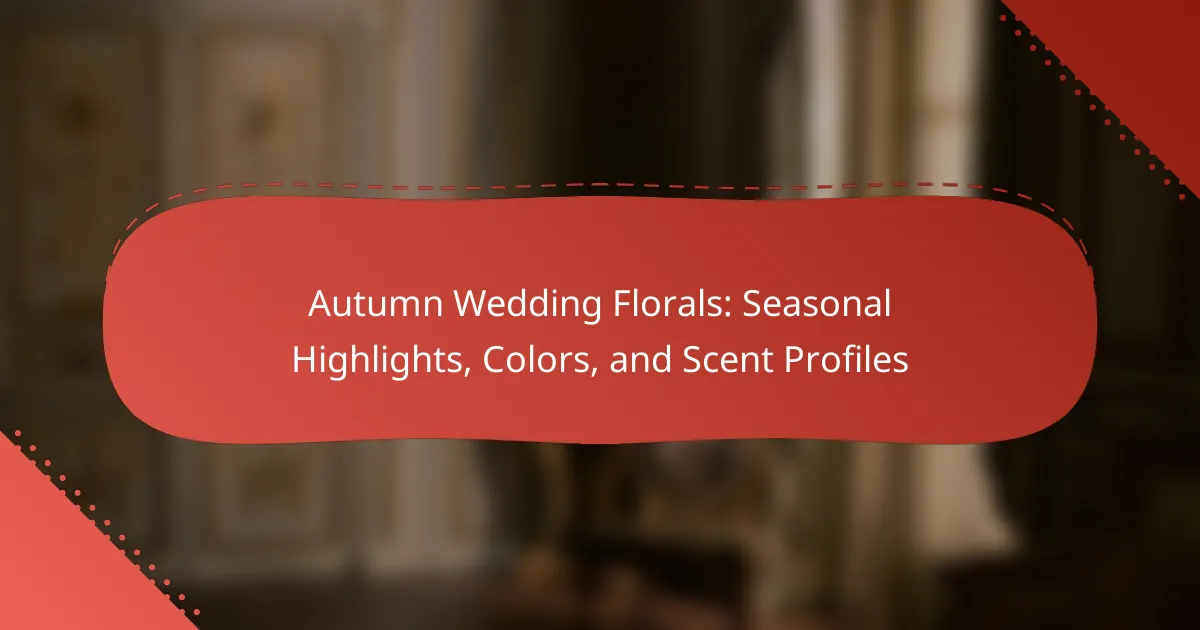
What are the key features of autumn wedding florals?
Autumn wedding florals are characterized by rich colors, seasonal blooms, and unique textures. The color palette often includes deep reds, oranges, yellows, and browns. Common autumn flowers include chrysanthemums, dahlias, and sunflowers. These blooms reflect the vibrant hues of fall foliage. Textures are enhanced with elements like dried leaves and grasses. Seasonal availability makes these flowers fresh and cost-effective. Additionally, autumn florals often incorporate berries and twigs for added visual interest. The overall arrangement aims to evoke the warmth and coziness of the season.
How do seasonal highlights influence floral choices?
Seasonal highlights significantly influence floral choices by dictating the availability and aesthetic appeal of specific flowers. For instance, autumn brings rich colors like deep reds, oranges, and yellows, which align with seasonal themes. Flowers such as chrysanthemums, dahlias, and asters are popular in this season due to their vibrant hues and hardiness. Additionally, scent profiles shift with the season, as certain blooms emit fragrances that evoke the essence of autumn, enhancing the overall atmosphere. The changing seasons also affect consumer preferences, with many seeking florals that reflect the natural beauty of the time. Studies show that seasonal floral arrangements are more likely to resonate emotionally with clients, leading to increased satisfaction and memorable experiences.
What types of flowers are in season during autumn?
Chrysanthemums, dahlias, and asters are flowers in season during autumn. Chrysanthemums bloom in various colors and are known for their longevity. Dahlias come in many shapes and sizes, providing vibrant hues. Asters are also popular, adding a touch of purple and blue to autumn arrangements. Other seasonal flowers include marigolds and sunflowers. These flowers thrive in cooler temperatures, making them ideal for fall weddings. Their availability aligns with the autumn months, ensuring fresh options for floral designs.
How do seasonal changes affect flower availability?
Seasonal changes significantly affect flower availability. Different flowers bloom in specific seasons due to temperature and daylight variations. For instance, spring brings tulips and daffodils, while summer features sunflowers and roses. In autumn, chrysanthemums and asters are prevalent, reflecting the cooler temperatures. Winter typically limits flower options, with fewer varieties available. The USDA Plant Hardiness Zone map indicates which flowers thrive in particular climates, influencing availability. Overall, seasonal variations dictate the types of flowers accessible at any given time.
What color palettes are popular for autumn wedding florals?
Popular color palettes for autumn wedding florals include deep reds, burnt oranges, and rich yellows. These colors reflect the changing leaves and seasonal warmth. Earthy tones like browns and greens are also favored. They create a natural and rustic feel. Jewel tones, such as emerald and sapphire, add elegance. Combining these palettes can create a stunning visual impact. Seasonal flowers often match these colors, enhancing the overall theme. Research indicates that these palettes resonate well with couples seeking a cozy atmosphere.
Which colors evoke the essence of autumn?
Warm hues such as orange, red, and yellow evoke the essence of autumn. These colors reflect the changing leaves during the season. Earthy tones like brown and gold also contribute to the autumn palette. Rich burgundy and deep green are frequently associated with fall as well. This color scheme creates a cozy and inviting atmosphere. The transition of nature during autumn inspires these color choices. They can be seen in seasonal decorations and fashion. The prevalence of these colors in nature during this time reinforces their connection to autumn.
How can color choices impact wedding themes?
Color choices significantly influence wedding themes by setting the overall mood and aesthetic. Different colors evoke distinct emotions and associations. For example, warm tones like red and orange create a cozy atmosphere, ideal for autumn weddings. In contrast, cool colors such as blue and green can impart a serene and refreshing vibe.
Color palettes also affect the selection of floral arrangements, decorations, and attire. A cohesive color scheme ensures visual harmony throughout the event. Studies show that color psychology plays a role in guest perceptions and experiences. Specific colors can enhance or detract from the intended theme, impacting everything from invitations to centerpieces.
What scent profiles are associated with autumn florals?
Autumn florals are typically associated with warm, earthy scent profiles. Common notes include spicy, woody, and musky fragrances. Flowers like chrysanthemums and dahlias contribute rich, robust aromas. Additionally, the scent of dried leaves and woodsy elements enhances the overall profile. These scents evoke a sense of warmth and comfort, ideal for the autumn season. Seasonal florals often incorporate hints of cinnamon, clove, and nutmeg, adding to their complexity. The combination of these elements creates a nostalgic and inviting atmosphere, perfect for autumn weddings.
How do scents enhance the wedding experience?
Scents enhance the wedding experience by creating emotional connections and setting the atmosphere. Specific floral scents, such as roses and lilies, evoke feelings of romance and joy. Studies show that fragrances can trigger memories, making moments more memorable for couples and guests. For instance, the scent of fresh flowers can create a sense of elegance and beauty. Additionally, unique scent profiles can personalize the wedding theme, reflecting the couple’s personality. Overall, scents play a crucial role in elevating the sensory experience during weddings.
What are the most fragrant flowers for autumn weddings?
The most fragrant flowers for autumn weddings include chrysanthemums, roses, and freesia. Chrysanthemums, often referred to as mums, emit a sweet and spicy aroma. Roses are classic choices, with many varieties offering rich and romantic scents. Freesia, known for its fruity fragrance, adds a unique touch to floral arrangements. Other notable options are gardenias and stock, both providing delightful scents that enhance the overall atmosphere. These flowers not only contribute to the visual appeal but also create a memorable olfactory experience for guests.

How can couples choose the right autumn florals for their wedding?
Couples can choose the right autumn florals for their wedding by considering seasonal blooms, color palettes, and scent profiles. Seasonal blooms include chrysanthemums, dahlias, and sunflowers, which thrive in autumn. Color palettes should reflect autumn hues like deep reds, oranges, and yellows. Scent profiles are important; couples can select flowers like roses or peonies that offer warm fragrances. Additionally, couples should consider the overall wedding theme and venue when selecting florals. Local florists can provide insights on available autumn varieties. Research shows that seasonal flowers are often fresher and more vibrant, enhancing the wedding’s aesthetic.
What factors should couples consider when selecting flowers?
Couples should consider flower type, color scheme, scent, and seasonal availability when selecting flowers. The type of flowers can influence the overall aesthetic and theme of the wedding. Color schemes should match the wedding palette to create visual harmony. Scent is important for creating a pleasant atmosphere. Seasonal availability ensures that flowers are fresh and can be sourced easily. Additionally, couples should consider their budget as certain flowers may be more expensive. Personal preferences and allergies should also be taken into account to ensure comfort and satisfaction.
How do budget constraints affect floral decisions?
Budget constraints significantly influence floral decisions for weddings. Limited financial resources often lead to selecting less expensive flower varieties. Couples may prioritize essential floral arrangements, such as bouquets and centerpieces, over elaborate decorations. This prioritization can result in a more minimalistic floral design. Additionally, budget constraints may encourage the use of seasonal flowers, which are typically more affordable. According to a survey by The Knot, 40% of couples adjust their floral choices based on budget. This adjustment can affect the overall aesthetic and mood of the wedding. Ultimately, budget constraints shape both the quantity and quality of floral elements chosen.
What role does the wedding venue play in floral selection?
The wedding venue significantly influences floral selection. The venue’s style dictates the overall aesthetic of the floral arrangements. For example, a rustic barn setting may call for wildflowers and greenery. In contrast, an elegant ballroom might require more structured and formal floral designs. The color palette of the venue also impacts flower choices. If the venue features warm autumn tones, florals in similar hues will create a cohesive look. Additionally, the size and layout of the venue determine how many arrangements are needed. Larger venues may require more substantial floral displays to fill the space effectively. Lastly, the venue’s lighting can affect how colors appear, guiding florists in selecting blooms that complement the ambiance.
What are the best practices for arranging autumn wedding florals?
Use seasonal blooms for autumn wedding florals. Incorporate flowers like chrysanthemums, dahlias, and sunflowers. These flowers thrive in cooler temperatures and offer rich colors. Select a color palette that reflects autumn hues, such as deep reds, oranges, and yellows. Utilize natural elements like branches, leaves, and berries to enhance arrangements. Consider varying heights and textures for visual interest. Ensure arrangements complement the wedding theme and venue. Finally, plan for the longevity of the flowers to maintain freshness throughout the event.
How can floral arrangements reflect the season?
Floral arrangements can reflect the season through the selection of seasonal flowers and colors. In autumn, arrangements often feature warm hues like orange, red, and yellow. Flowers such as chrysanthemums, dahlias, and asters are popular choices during this time. These blooms are readily available and evoke the essence of fall. Additionally, incorporating seasonal foliage, like maple leaves, enhances the autumn theme. Textures in arrangements can also mirror the season, with the use of berries and twigs. This combination creates a cohesive look that resonates with the fall atmosphere. Seasonal floral arrangements not only celebrate the time of year but also connect with the natural environment.
What styles are trending for autumn floral arrangements?
Trending styles for autumn floral arrangements include rustic, bohemian, and monochromatic designs. Rustic arrangements often feature natural elements like twigs and berries. Bohemian styles incorporate diverse textures and vibrant colors. Monochromatic arrangements focus on a single color palette, enhancing elegance. Additionally, dried flowers are gaining popularity for their longevity and unique aesthetic. Seasonal blooms like dahlias, chrysanthemums, and sunflowers are often used. These styles reflect the warmth and richness of autumn.

What are some unique ideas for incorporating autumn florals?
Incorporating autumn florals can enhance any setting with seasonal beauty. Use rich colors like deep reds, oranges, and yellows. Create centerpieces with sunflowers, dahlias, and chrysanthemums. Incorporate foliage like maple leaves for added texture. Use floral wreaths made of seasonal blooms for door decor. Arrange bouquets with berries and pinecones for a rustic touch. Utilize dried flowers for a long-lasting display. Consider floral installations that drape from ceilings or archways. These ideas leverage the unique attributes of autumn florals to create stunning visuals.
How can couples personalize their floral choices?
Couples can personalize their floral choices by selecting flowers that hold personal significance. They might choose blooms that represent their relationship milestones, such as the first flower exchanged. Couples can also consider their favorite colors to create a cohesive theme that reflects their personalities. Incorporating seasonal flowers can enhance the autumn aesthetic, aligning with the wedding’s overall vibe. Additionally, couples may opt for unique arrangements or containers that resonate with their style. Customizing scent profiles by selecting fragrant flowers can create a memorable olfactory experience. Personal touches, such as handwritten notes or family heirlooms in arrangements, can further enhance the personalization. These choices reflect the couple’s journey and make the floral arrangements uniquely theirs.
What creative alternatives exist for traditional floral arrangements?
Creative alternatives for traditional floral arrangements include using dried flowers, foliage, and non-floral elements. Dried flowers provide a rustic and long-lasting option. Foliage can add texture and depth without relying on blooms. Non-floral elements like fruits, vegetables, and herbs create unique centerpieces. Succulents and air plants offer modern aesthetics and low maintenance. Incorporating candles and lanterns enhances ambiance and visual appeal. These alternatives cater to various themes and styles, making them versatile for autumn weddings.
How can dried flowers be used in autumn weddings?
Dried flowers can be used in autumn weddings as decorative elements and bouquet components. They offer a rustic and timeless aesthetic. Dried flowers maintain their color and shape, making them ideal for long-lasting arrangements. Popular choices include lavender, eucalyptus, and strawflowers. These flowers complement autumn’s warm color palette, enhancing the seasonal theme. They can be incorporated into centerpieces, bouquets, and boutonnieres. Dried flowers are also eco-friendly and can be reused or preserved after the wedding. Their unique textures add depth to floral designs, making them visually appealing.
What tips can help couples maximize their autumn floral experience?
Couples can maximize their autumn floral experience by selecting seasonal blooms that thrive in cooler temperatures. Flowers such as chrysanthemums, dahlias, and asters are perfect for autumn arrangements. Incorporating rich, warm colors like burgundy, orange, and gold enhances the seasonal aesthetic. Utilizing natural elements like pinecones or branches adds texture and depth to floral designs. Couples should also consider the fragrance of flowers, as scents like cinnamon and clove can evoke the essence of fall. Planning floral arrangements ahead of time ensures availability and freshness of selected blooms. Consulting with a local florist can provide insights into the best autumn flowers for specific locations. Finally, incorporating personal touches, such as favorite flowers or meaningful colors, can make the experience more memorable.
How can couples ensure their flowers stay fresh throughout the event?
Couples can ensure their flowers stay fresh throughout the event by keeping them hydrated and cool. Hydration is crucial; flowers should be placed in water immediately after arrangement. A floral preservative can be added to the water to extend freshness. Keeping flowers in a cool location prevents wilting. Avoid direct sunlight and heat sources, as they can accelerate decay. Regularly check water levels and refill as needed during the event. Additionally, misting flowers with water can help maintain moisture. Research shows that flowers can last longer when properly cared for, enhancing their appearance throughout the occasion.
What are some common mistakes to avoid when choosing autumn florals?
One common mistake when choosing autumn florals is selecting flowers that are not in season. Autumn florals should reflect the natural blooms available during this time, such as chrysanthemums and dahlias. Another mistake is ignoring color coordination. Autumn is known for rich, warm hues like burgundy, orange, and gold. Failing to consider the overall wedding theme can lead to clashing aesthetics. Additionally, neglecting fragrance can be a misstep. Seasonal flowers often have distinct scents that enhance the atmosphere. Overlooking flower size and scale is also crucial. Large arrangements may overwhelm smaller venues. Lastly, not planning for longevity can result in wilted flowers by the end of the event. Choosing hardy varieties ensures blooms last throughout the day.
Autumn wedding florals are defined by rich colors, seasonal blooms, and unique textures that reflect the essence of the fall season. Key features include popular flowers such as chrysanthemums, dahlias, and sunflowers, along with color palettes that emphasize deep reds, oranges, and yellows. The article explores how seasonal highlights influence floral choices, the impact of scent profiles on the wedding experience, and practical tips for selecting and arranging autumn florals. Additionally, it addresses common mistakes to avoid and how couples can personalize their floral selections to enhance their wedding aesthetics.
